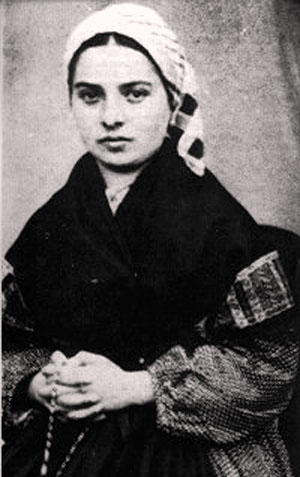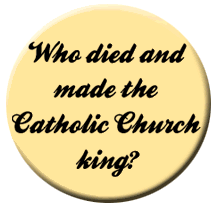Father, in your plan of salvation your Son Jesus Christ accepted the cross and freed us from the power of the enemy. May we come to share the glory of his resurrection, for he lives and reigns with you and the Holy Spirit, one God, for ever and ever. Amen. Alleluia.
St. Bernadette Soubirous (1844-1879)

Bernadette Soubirous was born in 1844, the first child of an extremely poor miller in the town of Lourdes in southern France. The family was living in the basement of a dilapidated building when on February 11,1858, the Blessed Virgin Mary appeared to Bernadette in a cave above the banks of the Gave River near Lourdes. Bernadette, 14 years old, was known as a virtuous girl though a dull student who had not even made her first Holy Communion. In poor health, she had suffered from asthma from an early age. There were 18 appearances in all, the final one occurring on the feast of Our Lady of Mt. Carmel, July 16. Although Bernadette's initial reports provoked skepticism, her daily visions of "the Lady" brought great crowds of the curious. The Lady, Bernadette explained, had instructed her to have a chapel built on the spot of the visions. There the people were to come to wash in and drink of the water of the spring that had welled up from the very spot where Bernadette had been instructed to dig. According to Bernadette, the Lady of her visions was a girl of 16 or 17 who wore a white robe with a blue sash. Yellow roses covered her feet, a large rosary was on her right arm. In the vision on March 25 she told Bernadette, "I am the Immaculate Conception." It was only when the words were explained to her that Bernadette came to realize who the Lady was. Few visions have ever undergone the scrutiny that these appearances of the Immaculate Virgin were subject to. Lourdes became one of the most popular Marian shrines in the world, attracting millions of visitors. Miracles were reported at the shrine and in the waters of the spring. After thorough investigation Church authorities confirmed the authenticity of the apparitions in 1862. During her life Bernadette suffered much. She was hounded by the public as well as by civic officials until at last she was protected in a convent of nuns. Five years later she petitioned to enter the sisters of Notre Dame. After a period of illness she was able to make the journey from Lourdes and enter the novitiate. But within four months of her arrival she was given the last rites of the Church and allowed to profess her vows. She recovered enough to become infirmarian and then sacristan, but chronic health problems persisted. She died on April 16, 1879, at the age of 35. She was canonized in 1933.
The Holy Gospel of Jesus Christ accoprding to Saint John (6.1~15)
Some time after this, Jesus crossed to the far shore of the Sea of Galilee (that is, the Sea of Tiberias), and a great crowd of people followed him because they saw the miraculous signs he had performed on the sick. Then Jesus went up on a mountainside and sat down with his disciples. The Jewish Passover Feast was near. When Jesus looked up and saw a great crowd coming towards him, he said to Philip, Where shall we buy bread for these people to eat? He asked this only to test him, for he already had in mind what he was going to do. Philip answered him, Eight months' wages would not buy enough bread for each one to have a little! Another of his disciples, Andrew, Simon Peter's brother, spoke up, Here is a boy with five small barley loaves and two small fish, but how far will they go among so many? Jesus said, "Make the people sit down." There was plenty of grass in that place, and the men sat down, about five thousand of them. Jesus then took the loaves, gave thanks, and distributed to those who were seated as much as they wanted. He did the same with the fish. When they had all had enough to eat, He said to his disciples, "Gather the pieces that are left over. Let nothing be wasted." So they gathered them and filled twelve baskets with the pieces of the five barley loaves left over by those who had eaten. After the people saw the miraculous sign that Jesus did, they began to say, "Surely this is the Prophet who is to come into the world." Jesus, knowing that they intended to come and make Him king by force, withdrew again to a mountain by Himself.
The Loaves
(Homily by Fr. E. J. Tyler)
In the Gospel of St John our Lord is presented as going back and forth between Galilee and Jerusalem in Judea. He comes from Galilee to Judea for the baptism of John and to begin his public ministry. He returns to Galilee where he changes the water into wine at Cana. Then “after not many days” at Capernaum, he “went up to Jerusalem.” There he cleanses the Temple, gives his discourse to Nicodemus and sojourns in the environs in Judea. Then he leaves for Galilee, passing through Samaria where he converts the woman at Sychar, together with many of her townspeople. Back again in Galilee where he cured the nobleman’s son, he returns to Jerusalem for “a feast of the Jews.” Then we notice — in the chapter from which our passage today is drawn — that he is back in Galilee again, where he works the miracle of the loaves for the five thousand men. Despite the danger, he returns to Jerusalem for the Feast of Tabernacles and teaches in the temple. There he encounters his enemies, disputes with them, teaching and healing. An attempt is even made to stone him. It is mentioned that he is in Jerusalem for the Feast of the Dedication — so possibly he has stayed from the Feast of Tabernacles to the Feast of the Dedication. He escapes an attempt to arrest him, going “beyond Jordan.” Then he returns to Bethany where he raises Lazarus, and then enters the City for his final redemptive act. Of course, no one would maintain that St John is meaning to present this sequence of events as exactly reflecting all historical details. It is a broad picture made up of significant “signs” and teachings. The feature I am drawing attention to here is the frequent reference to Jerusalem, its feasts and its Temple. These made up the centre of the religion of the chosen people and our Lord is portrayed as acknowledging this by his actions. The point is, I suggest, that many of the “signs” Christ works show that all of this will be transformed in the new dispensation. There will be a new centre, a new temple, new feasts, a new sacrifice and Jesus Christ himself will be its heart and soul.
We are surely alerted to this in our Lord’s first public intervention in Jerusalem, as presented by St John. It occurs in the second chapter, “and the Passover of the Jews was near at hand, and Jesus went up to Jerusalem.” Christ cleanses the Temple and points to himself — to his body — as the new Temple. After the Temple — his body — is destroyed, he will raise it up in three days. Inasmuch as this announcement occurs near the feast of the Passover, and inasmuch as Christ’s death itself would be a new Passover, we are reminded not only of the new Temple but also of the new Passover of his death that is coming. There will not only be a new Temple, but a new Passover, because there will be a new liberation from slavery. All of this brings us to our Gospel passage today. We notice that just as this first public manifestation of Christ in the Temple (John 2:13-25) was introduced by the circumstance that “the Passover of the Jews was at hand,” so the event portrayed in today’s Gospel (John 6:1-15) is also introduced by the same circumstance, expressed even in a very similar Greek wording. The Passover of the Jews was near at hand. Our Gospel event today then, also points to a coming transformation of the meaning of the Passover. Christ proceeds to feed the multitudes with a mere handful of food — just as the feast of the Passover is nigh. We remember the children of Israel being led out of slavery into the wilderness on their sojourn to the Promised Land. On the way they were fed from Heaven with manna sent by God. A new liberation is now coming, a new Passover, a new departure from the land of slavery in sin to the Promised Land of life in God. For the journey a new manna would be given, the true bread from heaven. That heavenly Bread is the body of Christ. He is our life. In the former event, the new Temple will be the body of Christ, risen from the dead. In the present event, the new manna will be the body of Christ, risen from the dead. Christ is destined to be man’s true life, his all, his means of life in God and his means of contact with God. The new religion revealed by God consists in union with Christ who is our Temple and our means of communion with the Father.
The miracle done, the people recognized that Christ was the promised Prophet, and the promised King — the Messiah. But they had entirely mistaken notions of the Prophet and the Messiah. They thought he would bring a new temporal liberation, of the same order only greater than that delivered by Moses. But no. Jesus Christ the Son of God had come to liberate the world from sin. He would do this by the sacrifice of his body as a victim on the Cross. The sacrificed Jesus is the ever-present sacrifice of the new people. He is its new Temple, and is its new and constant heavenly food for the journey to the Promised Land. We are speaking of the Holy Eucharist, the summit and source of revealed religion and of our entire Christian life.
~~~~~~~~~~~~~~~~~~~~~~~~~~~~~~~~~~~~~~~~~~~~~~~~~~~~~~~~~~~~~~~~~~

Character
Don't let your life be sterile. Be useful. Blaze a trail. Shine forth with the light of your faith and of your love.
With your apostolic life wipe out the slimy and filthy mark left by the impure sowers of hatred. And light up all the ways of the earth with the fire of Christ that you carry in your heart.
(The Way,1)





No comments:
Post a Comment